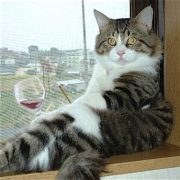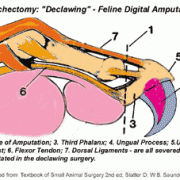Hey Einstein,
Dear Einstein, I don’t know what happened. One minute I was having the time of my life ripping up the couch and the next minute I’m waking up and my feet feel like they’re on fire. It’s been a week and it doesn’t burn as bad now, but those huge paper pellets my humans put in my pan hurt my paws whenever I use it. I don’t want to go anywhere near that box cuz I’m afraid it will hurt me again. Now my humans scream at me because I use the soft carpet instead.
No Longer Claus, just de-Claus
Dear De-Claus,
People think that declawing a cat is just an extreme nail trim, but that’s like saying Marie Antoinette had a short haircut. It’s an amputation, or rather ten individual amputations all done at the same time. I wouldn’t do that to a dog. It’s the human equivalent of cutting off all ten of their fingers at the first knuckle. Let’s see your humans work a computer keyboard like that. Or they should try walking with the first knuckle of their toes cut off.
A cat named Descartes once said, “I scratch, therefore I am.” After all, scratching is a natural part of being a cat. If you were a wild cat you’d use your claws to protect yourself, and catch your dinner. You’d also use them to climb trees, mark your territory, stretch and keep your muscles toned.
We kitties are one of the few creatures designed to walk on our toes instead of the flat part of the foot. If part of the toes disappears, that changes the way we walk. A couple of vets told me they see more arthritis in declawed kitties. We can’t balance on things like we used to and we can’t grasp with our non-existent claws, so we fall a lot.
The truth is, your people may have opened a big can of worms, and I’m not talking about the intestinal kind. Many of the kitties dumped at shelters are there cuz of problems that developed after their claws were ripped out.
In one study a large percentage of the toeless kitties left at the pound peed outside the box. As you said, that clunky cat litter they made you use right after your surgery really smarts. (I don’t know many humans who have to walk on gravel with cuts on their feet every time they need to pee.) You figured out real quick that your litter box was causing the pain. To protect your paws you found a quiet little corner where you could relieve yourself pain-free. Some cats go back to the box when their feet stop hurting, others don’t.
Other cats change from Dr. Jeckyll to Mr. Hyde after the surgery. We kitties rely on our claws as our primary means of defense. Without claws to occasionally provide a gentle reminder to stop bothering you, you have no choice but to start with the big guns or rather the canines. Even a minor encounter with the three-year-old kid could end with a bite cuz there’s no gentler way to say, “Don’t pull my tail.” Kitties who enjoyed hanging out with their humans may hide after their toe-ectomy.
It’s too late to put your nails back where they belong, but your humans could help you with the box situation by putting you in a small room or a cage and substitute a cardboard box for your old litter pan. The different smell and appearance might help you overcome your fear of it. Dr. Elsey’s Precious Senior Cat Litter has a very soft and comfortable texture on sensitive toes and it has a special attractant that makes kitties want to pee in it. They should put your food and water on the opposite side of the room cuz nobody, especially a cat, wants to eat near their bathroom.
Your humans should have talked to me before they cut off your toes. I could have given them some advice about how to keep both your feet and their furniture in tact. It takes a multi-faceted approach by a determined human to redirect a determined furniture scratcher. Most kitties will abandon the furniture if their humans give something they’d like to scratch in a prominent location while making scratching the furniture un-fun, and by giving you regular exercise and something to do during the day.
Contrary to human assumption, cats aren’t really sharpening their claws when they scratch the furniture. We’re conditioning them by removing the outer sheath and bringing to bear that really sharp new nail underneath. We’re also getting some exercise while we’re marking the furniture as ours. Oh yeah, we scratch cuz it just feels good.
Because humans are olfactorially-challenged, they don’t realize that when kitties scratch something they’re marking it with scent from their paws. In nature, cats often scratch trees as a warning of danger to other cats. Other times, they’re depositing their scent and leaving visual marks—kind of like gang graffiti. It’s not unusual for declawed kitties to start using the other end to mark, which humans don’t like either.
While we kitties are yanking on the upholstery, we’re keeping our bodies toned. If your people had ever taken time to watch you scratch, they might have noticed that you work every muscle group. I’ve observed that some of our humans could use a little of that same kind of toning.
The most important thing to consider when humans buy cat furniture is it must be heavy enough to support climbing and stretching. When we’re working toward those hard bodies, we don’t want a scratcher that wobbles. We need something that’s going to stay put no matter how much energy we put into it. After all, when your humans go to the gym, they avoid machines that totter. If you sink your claws into a post and it tips, you’ll say “Hasta la vista, baby.” A scratching post is a waste of money unless it stands at least thirty inches and has a heavy, stable base.
Kitties need an acceptable tree substitute. Planting a small forest in the living room would certainly give a cat incentive to abandon the sofa. And while green may be in, that may be more green than most décors can stand. A log with the bark still attached gives kitty the feel of the real thing. And despite their size, kitties also love cardboard scratchers.
If kitty’s giving a sturdy scratcher the cold shoulder, he may not like the way it feels. After all, cats have texture preferences. If a kitty isn’t into carpet, he might like sisal (rope). Others prefer wood or bark, others like fabrics with knobby, looser weaves, still others go after cardboard.
There’s a lot of bad information out there about how to get a kitty to use a scratching post or pad. Humans shouldn’t grab him and put his paws on the officially-approved scratcher to show him. After being manhandled, any self-respecting kitty’s going to say, “That ain’t happening.” Humans are more likely to entice cooperative scratching by running their own fingernails across the scratcher. Kitty’s going to think, “Oh, they’re scratching it; it must be good.” Any cat tree, post or pad should be spiked with catnip. And give him a treat every time he uses it.
A Realtor will tell you, one of the most important selling features of any a house is location. So the humans should put the post right next to the cat’s favorite couch. Once he begins using the scratching post on a regular basis, they can move it a few inches a day in the direction where they want it to rest, preferably in a high profile spot.
Humans have to take time to make your old scratching grounds unattractive. If it’s no longer fun, you’ll abandon it for something more satisfying. Since cats hate touching sticky stuff, double-sided tape like Sticky Paws (which is non-toxic and made especially for upholstery) makes the site un-fun. For really determined scratchers some humans use the adhesive in tandem with spray repellents. Humans think of the sprays as a magical force field like on the Enterprise, but they’re not. They have to constantly be reapplied.
A handful of kitties lose their toes cuz of scratching of the human kind. Kitty might attack hands and ankles cuz he’s got too much predatory energy. Sometimes scratching or biting humans is a habit that’s the human’s fault. It’s cute to let a six-week old kitten take a swipe at you. Not so much when he’s two years old and 10 pounds with machete-sharp claws. So smart humans won’t let a kitty think it’s okay to swat no matter his age.
Kitties may scratch toddlers because the kid won’t leave him alone. Shame on the parents for allowing the kid to torment the cat. Kitty should have lots of high up places where they can escape a little tail puller. While there’s a rug rat learning curve, kids need to be taught early on feline manners. When a cat doesn’t want to be held, a cat doesn’t want to be held. Until kids can be taught feline etiquette, your humans should have kept your claws trimmed. Sometime in flesh-ripping situations, nail caps can help, but owners will have to pay the vet for the pet-icure if kitty doesn’t tolerate nail trimming well.
Some cats get into interior re-design when they’re stressed or bored, which is an occupational hazard of the indoor kitty. In the wild kitties sleep 16 hours a day, but when we’re working, we’re really working. We climb trees, sprint after mice, leap for birds, and scratch up bark. We may not be punching a clock, but that’s a lot of work. A strictly indoor cat scratches furniture, stalks human feet, and climbs the drapes—activities similar to what he would be doing in the wild.
Humans can cut down on aggressive boredom and furniture shredding by getting a toy like DaBird (www.go-cat.com) and playing like crazy for 10 minutes twice a day. People often say, “Oh, my cat has toys.” But we need toys that do everything a live mouse or bird does. The only thing that can fill that need is a real mouse (filled with parasites) or a human with a really cool toy. When your human are away at work, they can put your kibble in a treat ball so you have to push it around to eat. That way you’d be focusing on getting your food (like a wild cat would) and you’d have less for mischief.
A decent scratching post, along with praise and treats for good behavior, would have had you eating right out of human’s hands.
De-Claude, I hope your people can help you become friends with your litter box again. If they’re patient and give you a chance, I bet you and your litter box and your humans can all live in harmony.
Ask Einstein: “Declaw”- Advice Column
Sourced from: Dusty Rainbolt’s Cat Einstein
 719-475-7297 or
719-475-7297 or 









